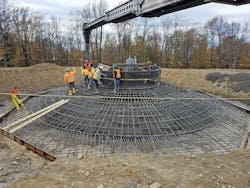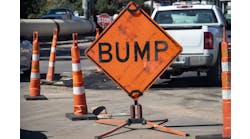By: Joseph Lowry III, P.E., and Sheila Ransbottom, P.E.
Many highway projects have portions of their contracts “set aside” to give what might be otherwise disadvantaged businesses a bit of an edge.
Some Request for Proposals (RFPs) will include up to a third of the contract value as being reserved for companies that meet the requirements of minority-owned, women-owned and service-disabled veteran-owned small businesses.
While it can add a layer of complication to the preparation of a proposal, large- and mid-sized firms have much to gain by utilizing partnerships with these types of small businesses. In addition to helping meet contracting requirements, these smaller firms offer a number of advantages: An understanding of local conditions and requirements, familiarity with local governments and regulatory bodies, specialized skill sets, and flexibility.
On Oct. 20, 2004, President George W. Bush signed Presidential Executive Order 13360, also known as the “Service-Disabled Veterans Executive Order.” This document laid the foundations of a program to honor veterans who have incurred disabilities during service with the U.S. Armed Forces by increasing federal contracting and subcontracting opportunities for service-disabled veteran-owned small businesses (SDVOSB).
This order directed federal contracting officers to establish a goal of not less than 3% participation by service-disabled veteran-owned businesses in federal contracts. This initiative joined similar set-aside programs for other categories of businesses, such as women-owned and minority-owned businesses, which have been in place for decades.
The ideas behind these federal set-aside programs, which broadly support and encourage meaningful opportunities for small businesses, have been adopted by many states, as well as some counties and municipalities. Increasingly, some of the most attractive, long-term road-related projects include set-asides. That is why it is important for large firms and project owners to learn how to turn them into a source of strategic advantage.
Successfully navigating these programs includes understanding some terminology. In order for a company to be eligible for SDVOSB set-asides they must meet certain requirements, which are described in detail by the federal agency issuing the contract. This often, but not necessarily, involves becoming certified through one or more government programs.
These requirements are intended to ensure that all companies describing themselves as SDVOSB meet minimum criteria related to the ownership and control of the business, which in turn meets the intent of Executive Order 13360 to increase contracting opportunities for this group of small businesses.
Common questions
How do I know if I need a veteran-owned firm as a partner in a contract?
The RFP or RFQ for a project will include information on set-asides such as the type (minority, women or veteran) and percentages. You also can check to see where the funding for the project is coming from. Even if the contract is coming from a county or municipal level, if there are federal or state dollars involved, there will likely be set-asides of some kind. It also is helpful to confirm the need for set-asides with the project owner; sometimes they remember the minority and women requirements, but forget about including the veteran requirements in the RFP.
How do I find veteran-owned firms?
The best way is to ask colleagues who they have worked with to meet set-aside requirements. If you are pursuing a project in a geographic area unfamiliar to you, reach out to local municipal officials or contacts you have at other local firms to ask who has a reputation for doing good work in the area.
The U.S. Department of Veterans Affairs Office of Small and Disadvantaged Business Utilization maintains a database of VOSB- and SDVOSB-verified businesses, as well as those verified as 8(a), HUBZone, woman- and minority-owned small businesses. The database is sortable using a wide range of criteria including location, keywords and business type. You also can check your local U.S. Small Business Administration Procurement Technical Assistance Center office, which provides support to small businesses. They may be able to point you to companies that meet set-aside program requirements.
How do I determine if a potential business partner actually qualifies?
Most businesses that fall under one of the small business certification categories are eager to work with partners in order to build business relationships as well as their own project portfolio. They will generally have certification or verification documentation close at hand to prove their “status” to potential partners. Always request this documentation. In addition, talk to them about their project and staff experience and qualifications.
Also, keep in mind that eligibility requirements may vary from agency to agency, and that certifications are not universal and may change over time. Therefore, it is best to check with the specific agency issuing the contract to ensure a potential partner is qualified under a specific program. Some agencies also may allow companies to “self-certify,” meaning they are not required to apply for certification through a particular program.
However, with all of this in mind, it is generally agreed that the VetBiz Vendor Information Pages program, managed by the Department of Veterans Affairs and the Center for Verification and Evaluation, is the most thorough certification for potential SDVOSBs. In order to be verified as a SDVOSB through this program, the company must provide extensive documentation to prove that company ownership, operating and control meets the criteria established by 38 CFR 74.4. This status is re-verified every two to three years.
What portions of a project are best outsourced to a set-aside firm?
The most likely services to outsource to set-asides are those that require specific skillsets that the prime might not have, services that can be done independently of other parts of a project, or services that can be blocked off in a project schedule. The most typical subcontracted project elements are surveying, environmental services, traffic analysis, landscape architecture, mechanical/electrical/plumbing engineering, fire protection, materials testing and special inspections.
What problems am I likely to encounter?
Capacity is a big one. Can the set-aside firm provide the manpower necessary for the project needs? Entrepreneurs are almost hard-wired to want to say “yes” to any job that comes in the door. Do not be afraid to ask how they will staff the project. It also is important to note that government contracts tend to be heavy on paperwork, particularly when it comes to verifying the role of the sub-consultant or supplier performing the set-aside work. You need to be sure that your potential teaming partner is aware of the volume of paperwork and knows how to hold up their end.
Also, determine whether the set-aside firm has the financial strength required. Many government contracts are slow with financial reimbursements. Particularly if the project owner is working on a pay-when-paid basis, it can be very difficult for the sub-consultant to hold its financial breath, meeting payroll and ongoing costs, until a check arrives. Note that many project owners will flow the insurance requirements downwards. It may be necessary for a small firm to afford a policy that would cover millions of dollars in damages.
How do I build a good relationship?
Be sure that the work you are offering is actually within the capacity of the set-aside firm you are considering. Offer a clear scope of work, budget and schedule at the onset. Strive to find a manager at the firm that can be your partner throughout the project. Maintain constant communication with the set-aside firm, not just at project milestones.
Consider alternative financial arrangements, so that you are providing some in-between payments to help the sub-consultant with their cash flow. This can go a long way to building good relations on the current project, as well as future projects.
Small business/set-aside firms are your partners in projects. Do not consider the necessity of meeting set-asides a burden, but rather an opportunity to build new and valuable business relationships. Most veteran-owned firms appreciate getting a foot in the door through set-asides, and they want a chance to prove themselves through good service and quality work. Their value lies in their expertise in their field, through being your “boots on the ground,” sharing their knowledge of local matters ranging from politics to hydrogeology and by meeting your contract goals.
With a bit of research, you will be able to find firms that can contribute solid value to your project and who may prove to be a valuable long-term partner.
About The Author: Lowry is CEO and president of Encorus Group. Ransbottom is civil/environmental lead at Encorus Group.



